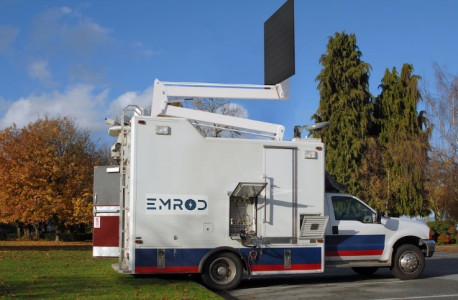
WHY THIS MATTERS IN BRIEF
If you want to connect remote communities to the electrical grid you can build expensive electricity pylons and bury cables, or now just stick up a cheap transmitter tower …
 Interested in the Exponential Future? Join our XPotential Community, future proof yourself with courses from our XPotential Academy, connect, watch a keynote, or browse my blog.
Interested in the Exponential Future? Join our XPotential Community, future proof yourself with courses from our XPotential Academy, connect, watch a keynote, or browse my blog.
Over the years there have been a wide variety of developments to help transfer electricity through the air wirelessly – whether it’s using it to charge the first generation of augmented reality contact lenses, or using massive conducting plates to charge electric vehicles, or transferring energy via laser or microwave links from space based solar power stations, or even over plain old WiFi.
Now though, back on Earth, a New Zealand based startup has developed a method of safely and wirelessly transmitting electric power across long distances and now they’re working on implementing it with the country’s second largest power distributor.
The dream of wireless power transmission is far from new though, everyone’s favourite electrical genius Nikola Tesla once proved he could power light bulbs from more than two miles away with a 140-foot Tesla coil in the 1890s – never mind that in doing so he burned out the dynamo at the local powerplant and plunged the entire town of Colorado Springs into blackout.
Tesla’s dream was to place enormous towers all over the world that could transmit power wirelessly to any point on the globe, powering homes, businesses, industries and even giant electric ships on the ocean, and then investor J.P. Morgan famously killed the idea with a single question: “Where can I put the meter?”
Courtesy: Emrod
It has taken 120 years, but New Zealand company Emrod appears to have finally convinced a major power distributor to have a crack at going wireless in a commercial capacity. Powerco, the second-biggest distributor in New Zealand, is investing in Emrod, whose technology appears to be able to shift large amounts of electricity much more efficiently, between any two points that can be joined with line-of-sight relays.
“We’re interested to see whether Emrod’s technology can complement the established ways we deliver power,” said Powerco’s Network Transformation Manager Nicolas Vessiot. “We envisage using this to deliver electricity in remote places, or across areas with challenging terrain without the need to install expensive [electrical] infrastructure. There’s also potential to use it to keep the lights on for our customers when we’re doing maintenance on our existing infrastructure.”
Emrod currently has a working prototype of its device, but will build another for Powerco, with plans to deliver by October, then spend several months in lab testing before moving to a field trial. The prototype device will be capable of delivering “only a few kilowatts” of power, but can easily be scaled up.
“We can use the exact same technology to transmit 100 times more power over much longer distances,” said Emrod founder and serial entrepreneur Greg Kushnir. “Wireless systems using Emrod technology can transmit any amount of power current wired solutions transmit.” And that’s a lot …
The system works by using a transmitting antenna, a series of relays and a receiving rectenna – a rectifying antenna capable of converting microwave energy into electricity. Each of these components appear in the images above and to the untrained eye simply look like big old squares on poles. Their beams then use the non-ionizing Industrial, Scientific and Medical band (ISM) of the radio spectrum, including frequencies commonly used in Wi-Fi and Bluetooth.
Unlike Tesla’s globally-accessible free power dream, the power here is beamed directly between specific points, with no radiation around the beam, and a “low power laser safety curtain” immediately shuts down power transmission before any object, like a bird, drone, power thief or helicopter, can touch the main beam. There will be no difficulties this time working out where to place the meter.
Emrod says it works in any atmospheric conditions, including rain, fog and dust, and the distance of transmission is limited only by line of sight between each relay, giving it the potential to transmit power thousands of kilometers, at a fraction of the infrastructure costs, maintenance costs and environmental impact a wired solution imposes.
Indeed, Emrod sees wireless transmission as a key enabling technology for renewable power, which is often generated far from where it’s needed. This kind of system could be terrific for getting the products of offshore and remote renewable energy generation into the city grids without the need for giant storage batteries and the like.
It’ll also be handy in certain unplanned outage events; a truck can be fitted out with a rectenna, and then driven anywhere in visual range of a relay to create a temporary wireless power connection – although when it comes to powering up electric vehicles there are other solutions emerging as well such as long range commercial solar powered and batteryless cars, as well as more common-a-garden peer to peer EV charging systems.
The company has been liaising with the Radio Spectrum Management authorities in New Zealand throughout its development process, with a view to meeting every safety standard even once the technology scales right up to high power levels, a process Kushnir says has also helped Emrod develop guidelines for the companies that will be using the technology in the future.
Source: Emrod


















